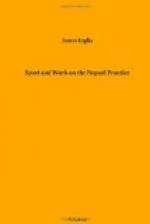In the cold mornings of December or January it hangs about like the peat smoke in a Highland village. Round every house are great stacks and piles of cow-dung cakes. Before every house is a huge pile of ashes, and the villagers cower round this as the evening falls, or before the sun has dissipated the mist of the mornings. During the day the village dogs burrow in the ashes. Hovering in a dense cloud about the roofs and eaves, and along the lower branches of the trees in filmy layers, the smoke almost chokes one to ride through it. I have seen a native sit till half-choked in a dense column of this smoke. He is too lazy to shift his position; the fumes of pungent smoke half smother him; tears run from his eyes; he splutters and coughs, and abuses the smoke, and its grandfather, and maternal uncle, and all its other known relatives; but he prefers semi-suffocation to the trouble of budging an inch.
Sometimes the energy of these people is surprising. To go to a fair or feast, or on a pilgrimage, they will walk miles upon miles, subsisting on parched peas or rice, and carrying heavy burdens. In company they sing and carol blithely enough. When alone they are very taciturn, man and woman walking together, the man first with his lathee or staff, the woman behind carrying child or bundle, and often looking fagged and tired enough.
Taking vegetables, or rice, or other commodities to the bazaar, the carrier often slings his burden to the two ends of a pole worn over the shoulder, much as Chinamen do. But they generally make their load into one bundle which they carry on the head, or which they sling, if not large and bulky, over their backs, rolled up in one of their cloths.
During the rice-planting season they toil in mud and water from earliest morn till late into twilight. Bending and stooping all the day, their lower extremities up to the knee sometimes in water, and the scorching sun beating on their backs, they certainly show their patient plodding industry, for it is downright honest hard work.
The young rice is taken from the nursery patch, where it has been sown thick some time previously. When the rice-field is ready—a sloppy, muddy, embanked little quagmire—the ryot gets his bundle of young rice-plants, and shoves in two or three at a time with his finger and thumb. These afterwards form the tufts of rice. Its growth is very rapid. Sometimes, in case of flood, the rice actually grows with the rise of the water, always keeping its tip above the stream. If wholly submerged for any length of time it dies. There are over a hundred varieties. Some are only suited for very deep marshy soils; others, such as the s[=a]tee, or sixty-days rice, can be grown on comparatively high land, and ripen early. If rain be scanty, the s[=a]tee and other rice crops have to be weeded. It is cut with a jagged-edged sort of reaping-hook called a hussooa. The cut bundles are carried from the fields by women, girls, and lads. They could not take carts in many instances into the swamps.




